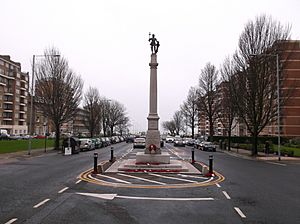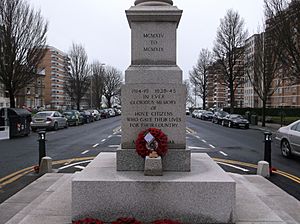Hove War Memorial facts for kids
Quick facts for kids Hove War Memorial |
|
|---|---|
| United Kingdom | |
 |
|
| For men from Hove killed in the First World War | |
| Unveiled | 27 February 1921 |
| Location | 50°49′37″N 0°10′07″W / 50.82683°N 0.16867°W Grand Avenue, Hove, East Sussex
|
| Designed by | Sir Edwin Lutyens |
|
Listed Building – Grade II
|
|
| Official name | Hove War Memorial |
| Designated | 2 November 1992 |
| Reference no. | 1187556 |
The Hove War Memorial is a special monument located on Grand Avenue in Hove, East Sussex, England. It was built to remember the brave people from Hove who lost their lives in the First World War. This important memorial was designed by a famous architect named Sir Edwin Lutyens. The statue on the memorial was created by Sir George Frampton.
The memorial was officially shown to the public in 1921. Today, it is recognized as a Grade II listed building. This means it's a very important historical structure that needs to be protected.
Contents
Remembering the Past
Why War Memorials Were Built
After the First World War, many countries faced a sad reality. Millions of soldiers and civilians had died. To honor these brave people, thousands of war memorials were built across Britain. These monuments helped communities remember the huge sacrifices made during the war.
The Famous Architect: Sir Edwin Lutyens
One of the most important designers of these memorials was Sir Edwin Lutyens. He was known as a leading architect of his time. Lutyens designed many famous memorials. One of his most well-known works is the Cenotaph in London. This monument is now the main place for national Remembrance Day events. He also designed the huge Thiepval Memorial to the Missing in France.
Lutyens also created the Stone of Remembrance. You can find this stone in many large cemeteries where soldiers from the Commonwealth are buried. The Hove War Memorial is special among Lutyens' designs. It features a bronze statue of Saint George, a feature only shared with one other memorial he designed.
Choosing the Design and Location
The idea for a war memorial in Hove started with local discussions. A special committee was formed to plan the town's memorial. They chose Sir Edwin Lutyens to be the architect. Lutyens suggested a few ideas, like an obelisk or a cenotaph. He even put up a wooden model of a cenotaph on Hove Lawns.
However, the committee decided they wanted a statue of Saint George instead. They also had trouble finding the perfect spot. Their first choice was rejected. Finally, Lutyens picked a site on Grand Avenue in June 1920. He chose a spot in the middle of the road, near the southern end.
Design and Details
What the Memorial Looks Like
The Hove War Memorial is quite tall, reaching about 10 meters (33 feet) high. It features a bronze statue of Saint George. Saint George is shown holding a sword. This statue was created by Sir George Frampton.
The statue stands on a grey granite column. Below the column, there's a two-part square base. This base sits on three shallow stone steps. At the corners of the bottom step, there are low stone posts. These posts were part of the original design. Metal lamp pillars have been added more recently.
Remembering Names and Dates
Unlike some memorials, the Hove War Memorial does not list the names of the fallen soldiers directly on it. Instead, their names are recorded on a bronze plaque. This plaque is kept safely in the Hove Library.
The main part of the memorial's base has important messages carved into it. On the north side, it reads: "IN EVER GLORIOUS MEMORY OF HOVE CITIZENS WHO GAVE THEIR LIVES FOR THEIR COUNTRY IN THE GREAT WAR AND WORLD WAR". This remembers those from both the First and Second World Wars.
The south side has another powerful message: "THEIR NAME LIVETH FOR EVERMORE". The dates of the wars are also carved in Roman numerals. For the First World War, it shows "MCMXIV TO MCMXIX" (1914–1919). For the Second World War, it shows "MCMXXXIX TO MCMXLV" (1939–1945).
Unveiling and Recognition
The memorial was officially unveiled on February 27, 1921. Lord Charles Wyndham, who was the Lord Lieutenant of Sussex, led the ceremony. Sir Edwin Lutyens was in India at the time. So, his office manager, AJ Thomas, attended in his place.
In 1992, the Hove War Memorial was given a Grade II listed building status. This means it's a historically important structure. In 2015, during the 100-year anniversary of the First World War, all of Lutyens' war memorials in England were recognized as a "national collection." Their historical records were updated and expanded.


